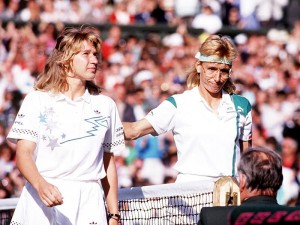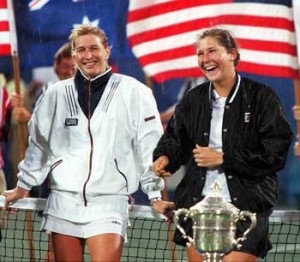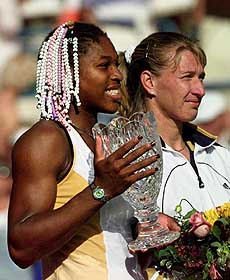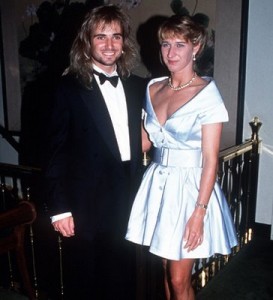Queens of the Court: Steffi Graf, A Golden Champion
Will you marry me?” someone called from the stands.
“How much money do you have?” was Steffi’s gravely delivered response, eyes fixed upon her opponent across the net.
The crowd erupted in laughter. It was Wimbledon, and a crowd, and player, not given to much jocularity. She’d been dating race car driver, Michael Bartels, for years, with no indication that anything more serious was coming out of it. It was an impertinent question, an improbable response, and so hugely funny at the time.
For me as a casual spectator (watching it on TV, from the horizontal position on the couch, no less), it was the first indication that the serious, un-smiling, un-’gamine,’ Steffi Graf might be interested in more than crushing opponents with hard-core resolve; be more than merely stoic in demeanor.
Stefanie Marie Graf. Born June 14, 1969. One of a few well-beloved living legends of this, or any, sport. Arguably the greatest woman’s champion of all time. She turned pro at age 13, at age 19 she completed one of the feats of all sports, a Golden Slam – a calendar year Grand Slam of tennis majors and an Olympic Gold medal (1988 – Sydney), that is only a part of her legend.
She retired in 1999, after almost 17 years in the sport, with a total of 22 major titles, second only in history to Margaret Court’s astounding 24.
What distinguished her (see summary at the end of the article), was ability on all surfaces. Some tennis players are grass court specialists (with a minor on hardcourts), for example. Not Steffi. She had terrific ability on all surfaces.
A superb forehand (she was dubbed ‘Fraulein Forehand’), top-notch foot speed, and a tremendous work ethic – a certain seriousness of purpose – made Steffi Graf an exemplary champion.
Temperamentally she might have been the diametrical opposite of the vivid Suzanne Lenglen, from history, who would go into histrionics, and even weep, on court, and who was a diva in the most raw sense. Steffi was cool on court, teutonic. It would be a demeanor that would only crack as she neared the end of her career.
Steffi came along as Chris Evert and Martina Navratilova’s careers were winding down. Her career overlapped with such greats as Monica Seles, Jennifer Capriati, Martina Hingis, Arantxa Sánchez Vicario, and even Serena Williams.
1987 was her breakout year, where she traded slam wins with Martina Navratilova, who was ranked world #1 at the time (Steffi won the FO and Martina, Wimbledon and the USO). Steffi finished that year with a 74-2 match record (her two defeats to Martina in the finals).

Graf and Martina Navratilova had some classic battles during Grand Slam tournaments.
In 1989, yet another fantastic Wimbledon final, Steffi defeated Martina 6-2 6-7 6-1, after defeating Monica Seles, Arantxa Sánchez Vicario, then Chris Evert in the semi-final. Here’s an excerpt – just look at the backhand that opens this excerpt! And in the 1989 USO, another late rally by Steffi saw her pull another one out against Martina after losing 6–3, 4–2 before coming back to win 3–6, 7–5, 6–1.
Steffi and Martina would trade slams several more times before Martina retired in 1994, including a moment in 1991 where a 35-year old Martina would beat 22-year old Steffi in the USO semifinals.
Chris Evert noted, after she’d retired, that she’d never played someone as intense in her whole career, and that Steffi possessed perhaps the greatest mental toughness of a female competitor in the history of the game.
Steffi and Arantxa Sánchez VicarioScrappy Spaniard Arantxa Sánchez Vicario was Steffi’s nemesis for a while. Arantxa Sánchez Vicario put a stop to Steffi’s march to a second Calendar Grand Slam in 1989, and handed Steffi her worst defeat, a couple of years later, again in the FO.
Steffi and Monica Seles.1990 saw the arrival of gamine and aggressive Monica Seles, who at age 16 won the French Open. Together, Monica and Steffi might have created one of the great sporting rivalries of all time, like their contemporaries: Chris Evert and Martina, or Sampras and Agassi.

Graf and Monica Seles seemed headed for a legendary rivalry before Seles' tragic stabbing.
Seles represented a new style of tennis – power baseline, aggressive tennis, with ear-splitting grunts to accompany maximum effort. Seles had a two-handed backhand and forehand, and was accurate on both wings, while Graf’s forehand was legendary, her foot-speed astounding, and her serve penetrating. Seles would end Steffi’s dominance of the majors, though Steffi was a contenda’ (to quote a famous movie) throughout this period, winning ten of their fifteen encounters.
When Seles was stabbed in 1993, and Martina having retired, Graf returned to an extended period of dominance of the women’s game.
Steffi and Martina HingisHingis’ career represents a unique story, and she could have her own chapter in our Queens of the Court Series. In the late 1990s [1997-2000], Hingis spent 209 weeks (compare with Roger Federer at 269, and Graf at 377 weeks) as world #1. Hingis resembled legend Suzanne Lenglen in terms of volatility, but without the maturity nor longevity in the sport, (if one can imagine Graf playing Lenglen!) During this time, Graf remained consistently near the top of the sport, but struggled with injury. Here’s a wonderful article by another writer here at b/r describing the ill-fated match-up of Graf and Hingis in 1999.
Steffi and Serena.

Serena Williams defeated Graf in the 1999 Indian Wells final.
Steffi and John McEnroeJohnny Mac, at age 40 was thrilled to be teamed up with Steffi Graf for mixed doubles at Wimbledon, 1999. I was thrilled to see them play in person at my very first Wimbledon – two living legends! On that same court, I had just seen Pete Sampras (up close and personal). It was Court 1, and I had paid 8 pounds for a grounds’ pass (since it was expected to rain all day, the ‘queue’ was almost non-existent.) I had no idea how lucky I was. Steffi would injure her leg that day and retire from the Mixed-Doubles semi-final, leaving Johnny Mac in the lurch. He was Very Disappointed. But what could he do? Little did we guess that it would be one of the last times we would see Steffi in competition. It would also be John McEnroe’s last competitive match at Wimbledon. After losing the Wimbledon final (to Lindsay Davenport, and beating Venus along the way) Steffi would say: “… in a way I still feel like a winner getting out of this tournament.” The next day Sampras and Agassi would play one of their classic finals. Here’s a NYT’s article from that period: Winning with Class, Exiting with Class
Steffi and Andre AgassiFor me, the line that opened this article was a moment in time that showed me that Steffi was about more than winning, and she instantly became a more intriguing person. In the below comment, the personable Andre Agassi, a long-time admirer of Steffi, who courted her in 1999, provides yet more insight into Steffi’s vision, her mental make-up, and ‘zen’ as a player and person.

Graf and Andre Agassi first met at the 1992 Wimbledon when both were tournament champions. They began dating in 1999 and were married in 2001.
The 2006 Sports Illustrated article “Coming Into Focus,” by author Gary Smith, is a fascinating look into Agassi’s life and career, and beautifully describes his unfolding relationship with Steffi (see part 2). It can be read in its entirety at these two URLs:
Part 1 http://observer.guardian.co.uk/osm/story/0,,1896736,00.html
Part 2 http://observer.guardian.co.uk/osm/story/0,,1896737,00.html
Some standout moments in this article include how superficial Steffi regarded Andre in their early years on the tour, including a hilariously cancelled ‘Champions Dance’ at the 1992 Wimbledon (see part 1 of the URLs above), and how, in selected moments in 1999 they discovered how much then had in common.
Now she likes to be called ‘Stephanie,’ a maturing change from the diminutive ‘Steffi’ that she used when she started playing at 13, and she lives in Las Vegas with Andre Agassi.
Summary of major Ladies’ Champions in History:
- Lenglen: 12 Grand Slam singles Titles (all surfaces); 1920 gold medal
- BJK: 12 Grand Slam singles Titles
- Evert: 18 Grand Slam singles Titles
- Navratilova: 18 Grand Slam singles Titles
- Wills: 19 Grand Slam singles Titles (all surfaces); 1924 gold medal
- Graf: 22 Grand Slam singles Titles ; 1988 gold medal
- Court: 24 Grand Slam singles Titles